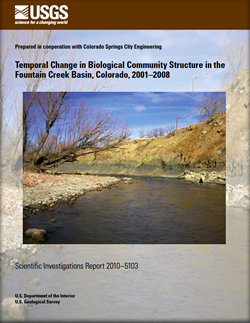Scientific Investigations Report 2010–5103

In 2001, the U.S. Geological Survey, in cooperation with Colorado Springs City Engineering, began a study to better understand the relations between environmental characteristics and biological communities in the Fountain Creek basin in order to aide water-resource management and guide future monitoring activities. To accomplish this task, environmental (streamflow, habitat, and water chemistry) and biological (fish and macroinvertebrate) data were collected annually at 24 sites over a 6- or 8-year period (fish, 2003 to 2008; macroinvertebrates, 2001 to 2008). For this report, these data were first analyzed to determine the presence of temporal change in macroinvertebrate and fish community structure among years using nonparametric multivariate statistics. Where temporal change in the biological communities was found, these data were further analyzed using additional nonparametric multivariate techniques to determine which subset of selected streamflow, habitat, or water-chemistry variables best described site-specific changes in community structure relative to a gradient of urbanization. This study identified significant directional patterns of temporal change in macroinvertebrate and fish community structure at 15 of 24 sites in the Fountain Creek basin. At four of these sites, changes in environmental variables were significantly correlated with the concurrent temporal change identified in macroinvertebrate and fish community structure (Monument Creek above Woodmen Road at Colorado Springs, Colo.; Monument Creek at Bijou Street at Colorado Springs, Colo.; Bear Creek near Colorado Springs, Colo.; Fountain Creek at Security, Colo.). Combinations of environmental variables describing directional temporal change in the biota appeared to be site specific as no single variable dominated the results; however, substrate composition variables (percent substrate composition composed of sand, gravel, or cobble) collectively were present in 80 percent of the environmental variable subsets that were significantly correlated with temporal change in the macroinvertebrate and fish community structure. Other important environmental variables related to temporal change in the biological community structure included those describing channel form (streambank height) and streamflow (normalized annual mean daily flow, high flood-pulse count). Site-specific results from this study were derived from a relatively small number of observations (6 or 8 years of data); therefore, additional years of data may reveal other sites with temporal change in biological community structure, or could define stronger and more consistent linkages between environmental variables and observed temporal change. Likewise current variable subsets could become weaker. Nonetheless, there were several sites where temporal change was detected in this study that could not be explained by the available environmental variables studied herein. Modification of current data-collection activities may be necessary to better understand site-specific temporal relations between biological communities and environmental variables. |
First posted August 24, 2010 For additional information contact: Part or all of this report is presented in Portable Document Format (PDF); the latest version of Adobe Reader or similar software is required to view it. Download the latest version of Adobe Reader, free of charge. |
Zuellig, R.E., Bruce, J.F., and Stogner, R.W., 2010, Temporal change in biological community structure in the Fountain Creek basin, Colorado, 2001–2008: U.S. Geological Survey Scientific Investigations Report 2010–5103, 19 p.
Abstract
Introduction
Methods
Temporal Change in Biological Community Structure
Environmental Variables Correlated to Temporal Changes in Biological Community Structure
Implications for Future Monitoring
Summary and Conclusions
Acknowledgments
References Cited